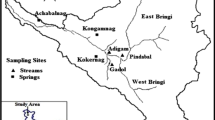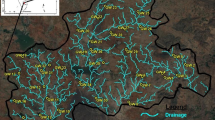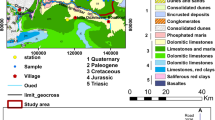Abstract
Groundwater recharge estimation has become a priority issue for humid and arid regions, especially in regions like Saudi Arabia, where the precipitation varies over space and time as a result of topography and seasonality. Wadi Tharad is a typical arid area in western Saudi Arabia. Within its drainage area of 400 km2, the groundwater system shows a graded hydrochemical zonation from the hydrocarbonate in the upper reach to the chloride zone in the lower reach. The saturation index (SI) varies depending on the concentrations of carbonate minerals; the mean for calcite and dolomite is about in equilibrium (e.g., zero value). As halite and gypsum indices are negative, it is undersaturated. Isotopic compositions of H and O in the groundwater show that the groundwater recharge resources are mainly from meteoric water. The chloride-mass balance method was refined to estimate the amount of recharge, which is probably 11% of the effective annual rainfall. These results can be used to improve the accuracy of future groundwater management and development schemes.






Similar content being viewed by others
References
Abdulrazzak MJ, Sorman AU, Alhames AS (1989) Water balance approach under extreme arid conditions: a case study of Tabalah basin, Saudi Arabia, Hydrol Proc 3:107–122
Alyamani M (2000) Salinity problem of groundwater in the Wadi Tharad basin, Saudi Arabia. GeoJournal 48:291–297
Basmaci Y, Al-kabir MA (1988) Recharge characteristics of aquifers of Jeddah- Makkah-Taif region. In: Simmers I (ed) Estimation of natural groundwater recharge, NATO ASI Series C222. Reidel, Dordrecht, pp 367–375
Bazuhair AS, Nassief MO, Al-Yamani MS, Sharaf MA, Bayumi TH, Ali S (2002) Groundwater recharge estimation in some wadi aquifers of the western Saudi Arabia. King Abdulaziz City for Science and Technology, Project No. AT-17–63, Riyadh, Saudi Arabia
Bazuhair AS, Wood WW (1996) Chloride-mass balance method for estimating groundwater recharge in arid areas: example from western Saudi Arabia. J Hydrol 186:153–159
Brown GF, Jackson RO (1960) Geologic map of the Asir quadrangle, Kingdom of Saudi Arabia. U.S. Geological Survey Miscellaneous Geologic Investigations Map I-217-A: scale 1:500,000
Carter RC, Morgulis ED, Dottridge J, Agbo JU (1994) Groundwater modeling with limited data: a case study in a semi-arid dunefield of northeast Nigeria. QJ Eng Geol 27:S85–S94
Cater FW, Johnson PR (1986) Geologic map of the Jabal Ibrahim quadrangle, sheet 20E, Kingdom of Saudi Arabia. Saudi Arabian Deputy Ministry for Mineral Resources Geologic Map GM-96: scale 1:250,000
Clark ID, Fritz P (1997) Environmental isotopes in hydrogeology. Lewis Publishers, New York
Eagelson PS (1979) The annual water balance. J Hydraul Div ASCE 105(HY8):923–941
Edmunds WM, Fellman E, Goni IB, Prudhomme C (2002) Spatial and temporal distribution of groundwater recharge in northern Nigeria. Hydrogeol J 10:205–215
Flint A, Flint L, Kwicklis E, Bodvarsson G (2002) Estimation recharge at Yucca Mountain, Nevada, USA, comparison methods. Hydrogeol J 10:180–204
Freeze A, Cherry J (1979) Groundwater. Prentice-Hall, Englewood Cliffs, New Jersey
Fritz P, Fontes JC (1980) Handbook of environmental isotope geochemistry. Elsevier, Amsterdam
Gat JR (1981) Groundwater. In: Gat JR, Geonfiantini R (eds) Stable isotope hydrology-deuterium and oxygen-18 in the water cycle. International Atomic Energy Agency Technical Reports Series 210, pp 223–239
Greenwood WR (1975) Geology of the Jabal Ibrahim quadrangle, sheet 20/40 C, Kingdom of Saudi Arabia with a section on economic geology, by Worl RG, Greenwood WR. Saudi Arabian Directorate General of Mineral Resources Geologic Map GM-22: scale 1:100,000
IAEA (1980) Arid zone hydrology: investigations with isotope techniques. In: Proceedings of an advisory group meeting, IAEA, Vienna
IAEA (1983) Paleoclimate and paleowaters: a collection of environmental isotope studies. In: Proceedings of an advisory group meeting, IAEA, Vienna
Kattan Z (2001) Use of hydrochemistry and environmental isotopes for evaluation of groundwater in the Paleogene limestone aquifer of the Ras Al-Ain area (Syrian Jazirah). J Environ Geol 41:128–144
Kondoh A, Shimada J (1997) The origin of precipitation in Eastern Asia by deuterium excess. J Jpn Soc Hydrol Water Resour 10(6):627–629
Lerner DN, Issar AS, Simmers I (1990) Groundwater recharge: a guide to understanding and estimating natural recharge. Int Assoc Hydrogeol, UNESCO International Hydrogeological Program. Hannover, Germany, vol 8, pp 345
Lloyd JW, Heathcote JA (1985) Natural inorganic hydrochemistry in relation to groundwater: an introduction. Oxford University Press, New York
Rozanski K, Araguias L, Gonfiantini R (1993) Isotopic pattern in modern global precipitation. In: Lohmann K, McKenzie KC, Swart J, Savin S (eds) Climate change in continental isotopic record. Geophys Monogr 78. Am Geophys Union, Washington, DC, pp 1–36
Şen Z (1983) Hydrology of Saudi Arabia. Symposium on Water Resources in Saudi Arabia, Riyadh, A68-A94
Shi JA, Wang Q, Chen GJ, Wang GY, Zhang ZN (2000) Isotopic geochemistry of the groundwater system in arid and semiarid areas and its significance: a case study in Shiyang River basin, Gansu province, northern China. J Environ Geol 40(4–5):557–565
Subyani AM (1997) Geostatistical analysis of rainfall in southwest Saudi Arabia. PhD Thesis, Colorado State University, USA, 182 pp
Ting CS, Kerh T, Liao CJ (1998) Estimation of groundwater recharge using the chloride-mass balance method, Pingtung Plain, Taiwan. Hydrogeol J 6:282–292
Wood WW (1999) Use and misuse of the chloride-mass balance method in estimating ground water recharge. Groundwater 37:2–3
Wood WW, Imes JL (1995) How wet is wet? Precipitation constraints on late Quaternary climate in the southern Arabian Peninsula. J Hydrol 164:263–268
Wood WW, Sanford WE (1995) Chemical and isotopic methods for quantifying groundwater recharge in a regional, semiarid environment. Groundwater 33:458–468
Author information
Authors and Affiliations
Corresponding author
Rights and permissions
About this article
Cite this article
Subyani, A.M. Use of chloride-mass balance and environmental isotopes for evaluation of groundwater recharge in the alluvial aquifer, Wadi Tharad, western Saudi Arabia. Env Geol 46, 741–749 (2004). https://doi.org/10.1007/s00254-004-1096-y
Received:
Accepted:
Published:
Issue Date:
DOI: https://doi.org/10.1007/s00254-004-1096-y




